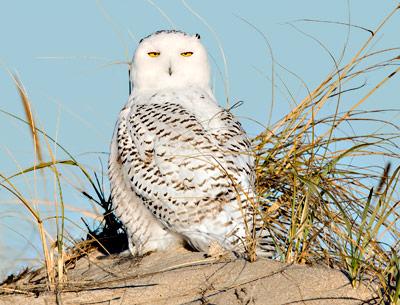‘Major Incursion’ of Arctic Owls Under Way

Angus Wilson knew this was an unusual year when surfers at Shinnecock Inlet asked him recently if he was there to see the owls.
Mr. Wilson, a research scientist at New York University Medical School and avid birder with a house in Springs, said that public interest in the owls had been sparked as dozens appeared along the Eastern Seaboard this fall in a massive migration that has left experts puzzled and casual observers pleased.
The surfers Mr. Wilson met were among the many people for whom awareness of snowy owls had reached beyond the usual birdwatchers’ circles. News stories, including on National Public Radio, fanned attention, as did social media.
An outcry earlier this month greeted news that the Port Authority had added them to the list of birds it kills at New York-area airports, after five planes were struck by snowy owls. Following objections, authorities said they would begin trapping and relocation rather than shooting.
Mr. Wilson said the increase in sightings was the result of a “major incur sion” of the Arctic species.
The Cornell Lab of Ornithology said 2013’s snowy owl numbers were an “incredible invasion.”
In ordinary years there might be one or two of the large, mostly white hunters wintering on the South Fork; 11 were seen during the annual Christmas Bird Count on Dec. 14 — a record.
In the 85 years that the Montauk Count, as the local effort is called, has been conducted, the previous high for snowy owls was six individuals. Mr. Wilson said he believed he had seen the first of this season here, in November at Hicks Island, off Lazy Point, which is a dependable location for those looking to see one for themselves.
More of the birds have been arriving ever since. There were five recorded on Gardiner’s Island during the Dec. 14 count. Mr. Wilson said his group watched as one plucked a duck from the surface of Great Pond at the island’s southern end.
Others were seen along Cartwright Shoal, a narrow isthmus of sand, cut in several places into low islands. These, Mr. Wilson said, might be observed by someone with a strong spotting scope from Gerard Point in Springs.
Another has pleased viewers at the entrance to Lake Montauk. This owl alternates from one side of the inlet to the other, he said.
Reports of the owl invasion are coming from Atlantic Canada and the Northeast and Great Lakes region, with sightings as far south as North Carolina and Bermuda. They have been seen in recent weeks in Arkansas, Minnesota, New Jersey, Massachusetts, Vermont, New Hampshire, and Michigan. One bird with an apparent fondness for traffic has been photographed several times perched on a highway bridge-approach sign in Queen Anne’s County, Md.
There is little consensus on what prompts the birds’ periodic and dramatic florescence. One clue, Mr. Wilson said, was that the individuals here appear to be young, distinguished from their nearly all-white elders by the dark barring on their breasts. A glut of young owls indicates a highly successful breeding season during the preceding high-Arctic summer, with the birds fanning out far and wide in search of food as they mature.
A population explosion among lemmings, which are a favorite meal for the owls, can result in females incubating as many as nine eggs per nest. Many of the snowy owls seen along the East Coast this year are first-winter, or immature, birds, according to Cornell, which maintains a web page updated daily with sightings of them at ebird.org.
Vicki Bustamante, a participant in the Montauk Christmas Bird Count, was part of a team that saw two snowy owls on Dec. 14 — one at Gin Beach, Montauk, and the other at Oyster Pond.
“All owls, it’s just a magical event when you see them, but a snowy owl, it just does something in your core when you see one,” she said.
She does not remember anything like this before. “It’s a crazy, eruptive year,” she said. “Experienced birders are shocked.”
Snowy owls generally hunt at night, Mr. Wilson said, feeding on roosting waterfowl. “They just swoop in and grab one.” Their highly sensitive eyesight gives them an advantage at nighttime, he said.
Snowy owls can also pick off prey during the daytime, one of the few large-bird species that can feed around the clock, on water or land.
Most of the time during the day, the owls settle to rest in exposed places, such as this area’s more desolate beaches. There they can gain easy access to the evening’s feeding grounds and see any potential predators, such as foxes, coming.
Roosting on the bare beaches and dunes they are quite visible, and their size makes them seem all the more exotic. At rest, their size, color, yellow eyes, and bulbously round heads are key identification marks. Flying, they appear huge, with wide wings tipped by finger-like, spread feathers.
Mr. Wilson said he was always concerned about the possibility that spectators might disturb the owls. He said that observers should use common sense about keeping their distance, and stay out of fragile dune areas, remaining in their vehicles or on roads or trails when looking at the birds.
Snowy owls will signal when they are becoming nervous, shuffling and stretching their wings. “If they are looking at you, that is an indication that you are too close,” he said.
Viewers will likely be able to see the owls on the South Fork until mid-March, when they depart for their summer range in the far north. Until then, people who frequent the outdoors will stand a good chance of sharing the beaches with them.
“This connects us to the Arctic,” Mr. Wilson said. “It shows us how connected we are to these places.”
